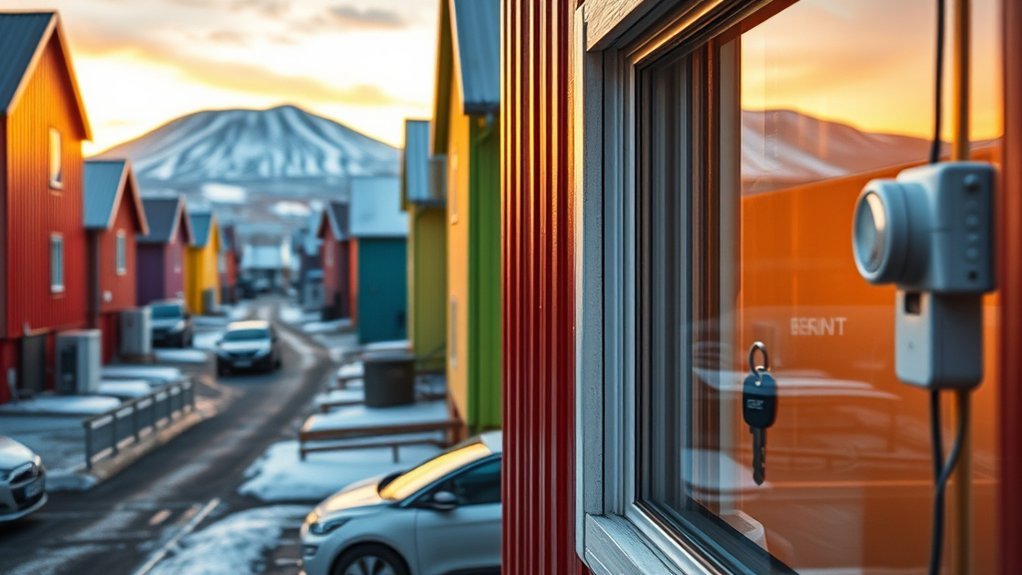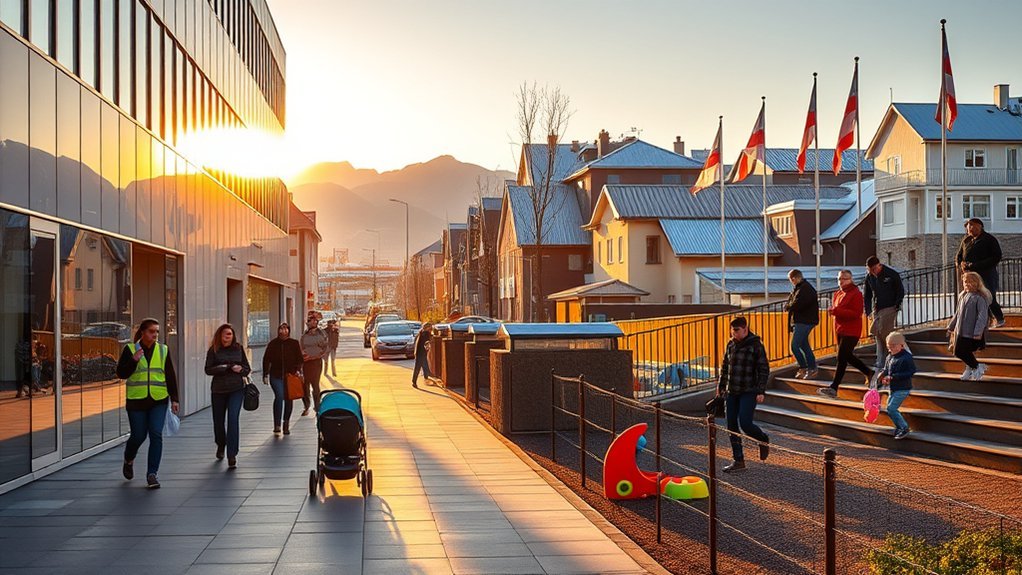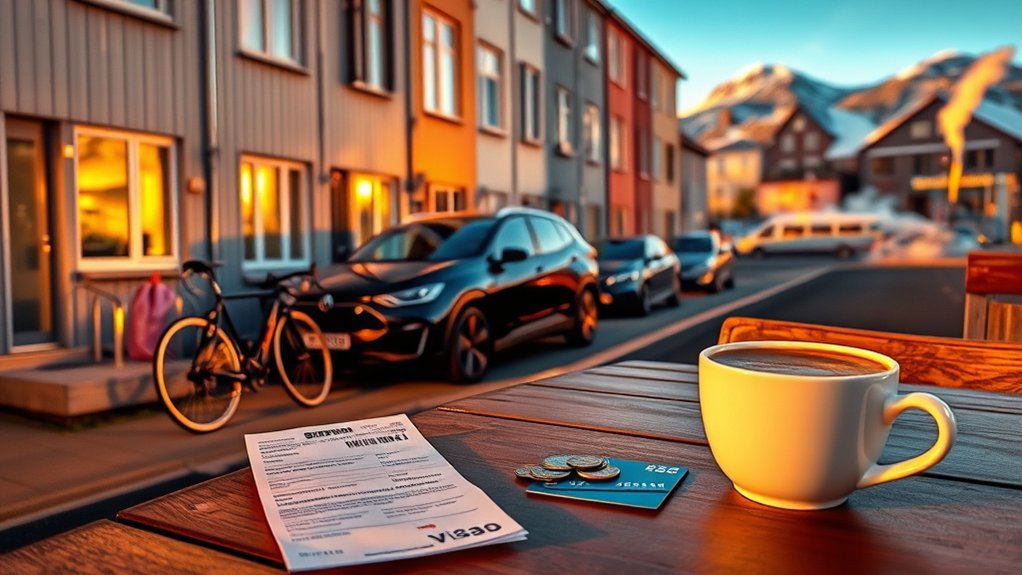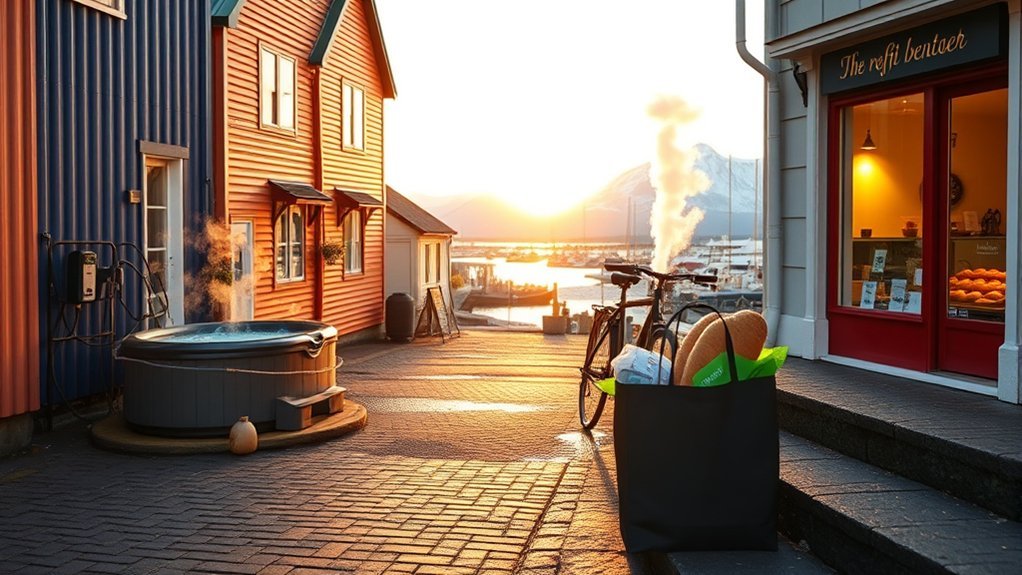You’ll pay noticeably more to live in Iceland than in most European countries, so plan budgets carefully: a central one‑bedroom runs ~275,000 ISK, groceries typically cost 50–100k ISK monthly, and public transit or car expenses add roughly 11,000 ISK or high fuel/insurance costs. Taxes fund strong public services like healthcare and education, cutting some out‑of‑pocket costs but lowering take‑home pay. Adjust by sharing housing, cooking at home, and choosing suburbs — keep going to see detailed cost tips.
Why Is Iceland So Expensive?

Because Iceland sits far from major markets, you’ll pay more for basics—imports cost extra thanks to long shipping routes and import taxes—while a small population means fewer suppliers and less price competition.
You’ll notice the high cost of living when imported goods carry transportation costs that double or triple prices you’d expect elsewhere. Compared to neighboring countries, many items are expensive compared with places with denser markets and better competition among suppliers.
High taxes fund robust public services like healthcare and education, so your take-home pay goes further toward social benefits but leaves less for discretionary spending.
High taxes support strong public services—healthcare and education—so take-home pay covers benefits but limits discretionary spending.
Local producers emphasize sustainable production, which raises unit costs but supports environmental goals you might value.
Finally, the tourism industry adds demand pressure year-round, pushing up prices for dining and services that locals and visitors share.
If you’re budgeting, prioritize essentials and hunt for local bargains to offset these structural cost drivers.
Housing, Utilities and Rent in Iceland

Expect to pay roughly 275,000 ISK (~$1,800) for a one-bedroom in central Reykjavik and about 150,000 ISK (~$1,080) or less outside the center, with larger places often topping 400,000 ISK.
Factor in utilities of 10,000–18,000 ISK and internet/TV of 6,000–12,000 ISK per month when budgeting.
To cut costs, you can look farther from the center, consider smaller units or shared housing, and compare listings carefully.
Rent Price Ranges
If you’re budgeting for housing in Iceland, plan on rent being one of your biggest monthly costs: a one-bedroom in downtown Reykjavík typically runs 200,000–300,000 ISK ($1,400–$2,200), while suburbs and smaller towns can drop to about 150,000 ISK ($1,080).
Expect city center apartments to command the top of that range; an apartment in Reykjavik will usually cost around the higher figures due to demand and limited supply.
When renting a one-bedroom apartment, factor housing into your average cost of living—many residents say rent outweighs other living expenses.
Compare suburbs versus central locations to save. Also weigh prices of everyday goods and average monthly utility costs separately so you know total living expenses before signing a lease.
Utility Monthly Costs
While rent will likely be your biggest housing expense in Iceland, utilities add a predictable monthly layer you should budget for: expect electricity of about 5,000–10,000 ISK and water/sewage around 5,000–8,000 ISK, with internet/TV typically costing 6,000–12,000 ISK. You’ll see higher bills in Reykjavik compared with outskirts; a downtown one-bedroom pushes total monthly expenses when combined with rent. The average apartment’s utility monthly costs (including heating, garbage) are roughly 12,000 ISK, which helps you estimate living expenses and plan a budget.
| Item | Typical ISK |
|---|---|
| Electricity | 5,000–10,000 |
| Internet/Water | 6,000–12,000 / 5,000–8,000 |
Finding Cheaper Options
One of the easiest ways to cut living costs in Iceland is to move outside central Reykjavik or share an apartment, where rents can drop from 200–300k ISK to around 150k ISK or less.
Utilities typically stay in the 12k ISK monthly range; combining a suburban one-bedroom or a room in a shared flat with budget internet (6–8k ISK) and shopping at discount grocers like Bónus will noticeably lower your monthly outlay.
You’ll compare city center prices with cheaper options and choose based on total expenses, not just rent.
Practical steps to reduce housing and utility costs:
- Share a flat to split rent and utilities.
- Live in suburbs for lower rent and similar services.
- Shop Bónus/Kronan to cut grocery expenses.
Food, Groceries and Dining Out

Because Iceland relies heavily on imports, you’ll find groceries and restaurant meals cost noticeably more than in many other countries, so budgeting becomes essential.
Because Iceland depends on imports, groceries and dining are significantly pricier, so careful budgeting is essential.
For food and groceries expect monthly grocery expenses for staples to range from 50,000 to 100,000 ISK ($360–$720); an average family often spends about 80,000–100,000 ISK. You can cut costs by shopping at budget-friendly chains like Bonus and Kronan, where basic items and free shopping bags help keep totals lower.
Dining out and eating out raise expenses fast: breakfast at inexpensive spots runs about 2,000–3,500 ISK ($14–$25), while dinner mains commonly cost 4,000–8,000 ISK ($29–$58).
Alcohol prices are steep — roughly 140% above the EU average — with vodka around 7,200 ISK ($52) and beer 1,000–1,700 ISK ($7–$12).
Given high restaurant costs and reliance on imported goods, plan monthly budgets around higher food bills and prioritize cooking at home when possible.
Transportation: Cars, Fuel and Public Transit

After you’ve figured out how to cut food costs, you’ll want to plan how you’ll get around—transportation can be another big line item.
You’ll weigh public transportation versus car ownership: city buses are cheap for short trips (single fare ~450 ISK) and a monthly bus pass runs about $104.1, but routes don’t reach everywhere.
Buying a car gives flexibility but brings high vehicle expenses—fuel prices near $8 per gallon and insurance costs around 16,000 ISK ($115) monthly add up fast.
- Compare monthly costs: monthly bus pass vs. fuel + insurance and taxi fares for occasional trips.
- Factor in taxi fares when you need on-demand rides—base 500–700 ISK plus ~400 ISK/km.
- Remember indirect costs: maintenance, parking, and registration raise total car ownership.
For living in Iceland on a budget, favor public transportation in cities and rent or share a vehicle for rural trips to control overall costs.
Healthcare, Childcare and Education Costs

While healthcare in Iceland is largely state-funded and affordable, you should still plan your budget around the modest out-of-pocket fees for routine and emergency care—health center visits run about 500 ISK ($3.57) for insured patients and emergency treatments start at roughly 2,000 ISK ($14.29).
You’ll benefit from universal healthcare that keeps most medical costs low, so routine prescriptions and specialist visits rarely blow your budget.
For families, childcare is heavily subsidized: daycare averages about $500 per month from age one, and kindergarten fees sit between $190–$270 monthly, both competitive compared with many countries.
Public education is free through compulsory schooling, reducing household education costs, while public university tuition fees are relatively low — roughly 75,000 ISK ($535) per year.
When planning expenses, factor in these predictable, affordable costs: minor healthcare copays, monthly childcare or kindergarten payments, and modest university tuition fees if you or your dependents pursue higher education.
Taxes, Wages and Personal Finance

If you’re budgeting for life in Iceland, plan on high taxes shaping your take-home pay: the progressive income tax system pushes combined rates from about 20% up to over 50% for top earners, though a monthly personal tax credit (68,691 ISK) cushions much of the burden.
You’ll compare gross wages to net income carefully: the average monthly salary sits near 758,000 ISK (about $6,000), but after income tax and social charges you’re often left with roughly $3,000 monthly.
Minimum wage is around $2,800, so entry-level workers get a reasonable baseline.
- Factor taxes: high-income tax rates cut disposable income, but the personal tax credit reduces monthly liability.
- Compare wages: average monthly salary versus net income tells you real purchasing power relative to cost of living.
- Seek job opportunities in tourism, renewable energy, or healthcare; foreign hires need pre-approved offers to secure work and income.
Lifestyle, Entertainment and Everyday Expenses

One predictable expense you’ll face in Iceland is leisure and everyday spending, and budgeting around 30,000 ISK ($230) a month for activities will keep most people comfortable. You’ll allocate that toward entertainment and everyday expenses like dining out, cultural events, and occasional paid outdoor activities.
A night at the National Theatre costs about 4,600 ISK ($34), so attending a couple of shows eats a noticeable slice of your monthly leisure activities budget.
You can trim costs: outdoor activities such as hiking are often free, while skiing or guided trips add up. Dining at inexpensive restaurants runs roughly 2,500–4,500 ISK per meal, so limit restaurant visits if you’re watching the monthly total.
Public transportation is reasonable — a monthly pass is about 11,000 ISK ($75) — and will lower commuting expenses compared with taxis. Balance paid entertainment with free outdoor options to keep your lifestyle affordable without sacrificing social or cultural life.
Frequently Asked Questions
Is It Cheaper to Live in Iceland or the US?
You’ll generally find the US cheaper; cost comparison shows Iceland’s living expenses rise from housing market and food prices, plus higher utility costs and transportation fees, while healthcare expenses, education costs, entertainment options and lifestyle differences vary.
Can US Citizens Live in Iceland?
Yes—you can live in Iceland if you secure work permits or residency process approval; you’ll manage visa requirements, health insurance, job opportunities, cost of living, education options, cultural adaptation, local customs, and language barrier with budget planning.
What Is the Average Income in Iceland in US Dollars?
The average salary in Iceland is about $4,500–$6,000 monthly; you’ll weigh cost comparison, job market, currency exchange and living expenses, factor taxation rates, expatriate challenges, remote work options and solid financial planning for budgeting.
How Much Is a House in Iceland in US Dollars?
You’ll find Icelandic house prices range roughly $200,000–$1,000,000+, with urban housing pricier; compare real estate, rental markets, mortgage rates, property taxes, housing trends, rural properties, living expenses and investment opportunities for budget planning.
Conclusion
Living in Iceland will cost you more than in many places, but you’ll get strong wages, good services and stunning nature. Compared with elsewhere, expect higher rent, groceries and fuel; balance those with higher salaries and social safety nets. Budget tightly for housing and food, use public transport, and plan healthcare and childcare costs. Think like a Viking trader with a smartphone—prioritize essentials, track expenses, and you’ll make Icelandic life affordable.


